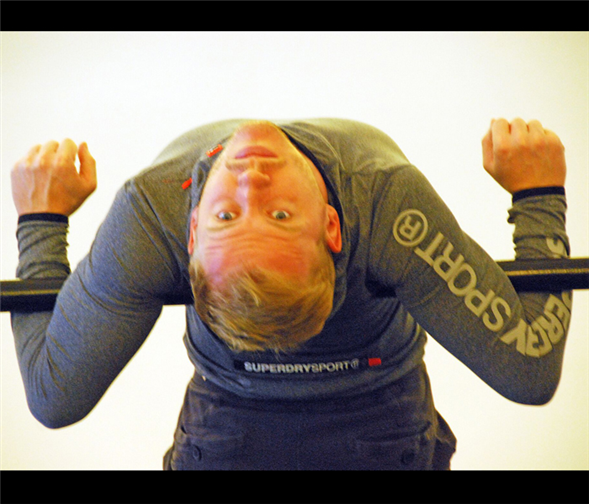Translate Page

The legendary choreographer presents a rare revival of her material
---
Last November Twyla Tharp marked her 50th anniversary as a choreographer in a big way – with a program of two brand-new works at Lincoln Center. But Tharp – ever the disciplined and creative choreographer – has more to offer in celebration of this milestone. Through July 23, her current group of exemplary dancers is at the Joyce Theater with a completely different program.
And though she's a determinedly forward-looking artist, and said that the anniversary wouldn't be an occasion for a retrospective, Tharp (who recently turned 75) has decided to revive two vintage works from one of her most fertile and fascinating periods.
Country Dances, created in 1976 and last performed by Tharp's company in New York in 1979, is a robustly playful yet intricate work for three women and a man, set to down-home country tunes with titles such as "Rat Cheese under the Hill" and "Texas Quickstep."
The 1980 Brahms Paganini is set to Brahms' virtuoso piano composition Variations on a Theme by Paganini, Opus 35 (Books I & II). For Book I, Tharp created an extended male solo – the apotheosis of Tharpian male technique, in which intricate, complex steps come across with deceptively casual grace. Book II features two couples in split-second partnering, with a lone woman weaving her way through. In a 1980 interview, Tharp described the male solo as a "heroic undertaking" and said that "the quartet shows the underside of romance, a lot of unlovely stuff."
And while she has allowed herself a glance back in time, Tharp also has a new work, Beethoven Opus 130, to share the program with these revivals. This premiere for eight dancers is set to one of Beethoven's late string quartets (three of its six movements), and it features veteran Tharp dancer Matthew Dibble in a central role.
The nine members of this current incarnation of Twyla Tharp Dance performed in last fall's program, and they all had some form of prior Tharp connection. Some first encountered her through one of her Broadway productions, while others were in ballet companies that performed her pieces.
Two of these dancers – just back from dancing the program in Italy – sat down to talk a few weeks ago at Tharp's Upper West Side office. Amy Ruggiero, whose feisty presence and go-for-broke energy made an impression last fall, performed in the national tour (and a Tokyo production) of Come Fly Away, Tharp's 2010 Broadway dance show set to Sinatra songs. Daniel Baker, an Australian whose résumé includes Miami City Ballet (where he danced many Tharp roles and worked with her on a premiere), is a smooth, subtle performer who seems born to inhabit Tharp's choreography.
{Image1}
After spending much of last year creating and performing Tharp's new dances, one wonders what it was like for them to go back in time to learn choreography she devised before they were born. "The challenge is capturing the spirit of that time period," says Ruggiero. "There was such a strong sense of community in her pieces. We're learning a lot about dancing within our group. It's a ton of pressure to revisit them, because you want to maintain the integrity of what they were when they were first created."
From the mid-70s to the mid-80s Tharp had an ensemble of devoted dancers who were totally immersed in her style, up for any challenge she threw their way. This was at a time when she was consolidating her invigorating blend of classical, modern , and social dance moves.
"In the Brahms, we all need each other – otherwise the choreography doesn't work!" Baker says. "The quartet has intense partnering. If one person's not there for the other, it just crumbles." Adds Ruggiero, "I think both works show how timeless her movement is. They could have been created yesterday. They're so athletic, and there's humor.
The company worked on these dances intensively during a six-week spring residency in the Catskills, rehearsing in a barn studio with access to a theatre down the road. "It was great to be out of the city with no distractions," Baker says.
Back in New York, they were thrilled when Shelley Washington, one of Tharp's finest interpreters and an original cast member of both dances, spent several days working with them. "Shelley was so helpful with everything," says Ruggiero. "She had so much to say, remembered how they did it, and offered details you didn't notice on the video – a little gesture or look. She had so much to give us that brought it back to where it really belongs."
{Image2}
Baker adds, "It was really good to get all that information, but at the end of the day, Twyla really lets you be yourself. That's what really draws me to her. She's very good at giving you a range. She gives you material where she will let you grow, whether it's dramatically or technically.
"I love the athleticism that Twyla's work requires, and I love working for a strong woman. I don't know why. I feel like sometimes male egos can get in the way, working in a professional environment. To have such a genius mind – you have such a respect there. I love the independence she gives us, and the collaboration. I feel like I've learned something in every rehearsal."
Ruggiero agrees, adding: "I love the way she allows us to have choice in the movement within a given framework. You really learn from that, because it encourages you to take risks. And that has translated into other things for me – having that ability to stretch yourself to places that you didn't think you would go. I enjoy bringing something new to a work every time that we do it."
---
Susan Reiter regularly writes about dance for TDF Stages
Photos by Gene Feldman. Top photo: Daniel Baker in rehearsal.